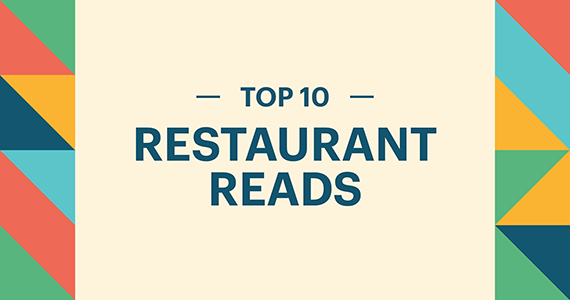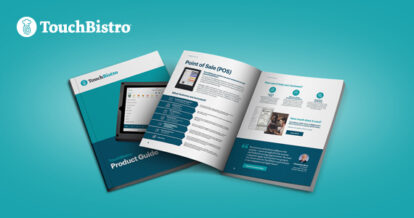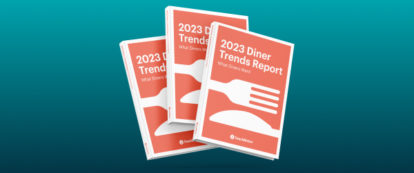A restaurant training manual is a fantastic training tool that can increase employee productivity and performance.
Keeping your team motivated and inspired is especially important during the current labor shortage, which has made hiring more difficult than ever. High unemployment rates and employee turnover are negatively impacting profitability across North America and restaurant owners are struggling to attract and retain new talent.
When replacing staff, you need to budget for hiring, recruitment, interviewing, and training – taking your focus away from your core responsibilities and growing your business. These processes are important because untrained staff can lead to negative guest experiences.
A restaurant training manual can help make training new staff an easier and faster process. Acting as a single source of truth for your restaurant procedures, dress code, and more, a training manual ensures that new hires can get onboarded quickly and efficiently.

Download this customizable restaurant training manual template to ensure a smoother onboarding and training process for staff.
To help you create your own restaurant training manual, we’ve broken the process down into just a few easy steps. In this guide, you’ll learn:
- What a restaurant employee training manual is
- The key features of a training manual for restaurants
- Tips for putting together your own training manual and a free template to get you started
What Is a Restaurant Training Manual?
A restaurant training manual is a guide that your employees can use to understand all of the rules and guidelines for working at your restaurant. Acting as a single source of truth, it includes key information such as processes and procedures, employee etiquette, health and safety policies, language to be used, and how to dress on the job.
Your training manual should be given to new staff along with your restaurant employee handbook and restaurant employee benefits package during your onboarding process. It should also be included as part of your new hire checklist for restaurant employees.
Restaurant employee training manuals offer restaurateurs four major benefits, including:
- Motivating staff: Your training sets the standard for your restaurant – nurturing your team spirit and bringing staff together to work towards common goals.
- Reducing turnover: If you give staff responsibility from day one, they will feel trusted, more confident in their role, and be less likely to leave your company.
- Fostering a positive work environment: Including staff in your vision and providing tips to improve their food service skills shows that you take your staff roles seriously.
- Increasing job satisfaction: Outlining all of your rules will decrease individual staff questions and prevent errors, ultimately improving your team’s attitude and confidence.

Key Features of a Training Manual for a Restaurant
Your restaurant training guide should include everything you want new and existing staff to know about working at your restaurant. Common topics include your company’s background information, your core values, and any policies or procedures they should know about, as well as any specific restaurant job descriptions and expectations.
Not sure where to start? Here are the key features to include in your restaurant employee training manual. You’ll also find ideas and tips on how to make it interactive and engaging.

Download this customizable restaurant training manual template to ensure a smoother onboarding and training process for staff.
Cover Page & Table of Contents
Create a professional-looking restaurant training guide by starting with a cover page and table of contents.
Cover Page
A cover page differentiates your restaurant employee training manual from others with your unique brand elements such as your logo, restaurant name, and address. It should include your contact information so employees know where to reach you, should they have further questions.
Table of Contents
A table of contents makes it easier for staff to navigate your document. This is especially useful when employees need to refresh their memory on specific topics, saving them both time and effort. Thankfully, you can easily create a table of contents in most text editors like Pages or Word.
Here’s an example table of contents:
- Section 1: Introduction
- Section 2: Training
- Section 3: Roles & Responsibilities
- Section 4: Technology
- Section 4: Health & Safety
- Section 5: Conclusion
Introduction
Your introduction gives staff a brief overview of your restaurant. Consider the following sub-headers to include:
Welcome Section
In this section, you should present a personalized note to new employees from a lead staff member. This is a great opportunity to express appreciation and let new hires know why you’re excited about them joining your team.
History of Your Restaurant
Let your new employees know how your restaurant was founded and any major milestones along the way. By being transparent about your company background, you will build a more personal connection with your employees and help them better understand why they’re joining your team.
Mission Statement
Your mission statement lets employees know what your restaurant does and why you run it every day. Typically, your mission statement sets the tone for your restaurant and outlines what your goals are so that everyone can be on the same page.
Core Values
Present an overview of your core company values. If everyone works with the same core values in mind, you’ll be able to maintain your brand image much more effectively.
Guest Experience
Tell new hires how their role will contribute to your overall guest experience. For example, explain how increasing efficiency at work directly improves the customer experience.
Other information you may want to consider adding to this section can include:
- How to greet and speak appropriately to guests
- How to be attentive and resolve guest concerns
- How to support or help run special events
Training
Your training section outlines details about your training program and why it exists. Consider the following sub-sections to include:
Company Expectations
By outlining your expectations, you can remove confusion. Let new hires know what the end goal of their training is and what success looks like. Will they be tested on their skills? Is there a certification process involved?
Remember to also explain your expectations of a fully onboarded employee. What or who are they responsible for? If they have questions, who should they go to for help?
Timeline
A timeline will help new hires familiarize themselves with their duties and reduce stress by ensuring they know what to expect. Whether you provide a week crash course or a 30-day training period, outline each action item in detail, along with its expected completion date.
Why the Training Exists
Explain the importance of the overall training experience and how it relates to guests and staff. For example, you can outline why it’s important for restaurants to include health and safety training and how it protects everyone’s best interests. Additionally, you can explain the specific benefits of any classes or certifications that new hires must complete, like obtaining a food handlers permit.
Role & Responsibilities
Once you’ve built some excitement around your brand, it’s time to break down employee roles and responsibilities by team. This section is also ideal for setting expectations and letting staff know how they’ll be evaluated.
Here’s a sample list of expectations you could include to keep your business running smoothly:
- Responsibilities for each department: Make sure to use conversational language, as if you’re talking to them in person.
- Dress Code: Tell staff how each team member should dress for work and what they should avoid wearing.
- Cleaning Procedures: Clearly communicate any restaurant cleaning or sanitizing instructions.
- Health Guidelines: Let staff know any health policies, like if they should stay home when they are feeling ill.
As a bonus, consider adding visuals to this section, like a map or workflow that walks your reader through restaurant job descriptions. You can also add role-specific imagery in separate server training manuals.
If you want to really take your restaurant training manual up a notch, consider creating videos featuring current staff to share digitally. These videos can help to build a connection between your current staff and new hires.
What to Include for Front of House Staff
If your new hire is working in the front of the house, you should provide a clear outline of how they should interact with guests. For example, consider adding the following:
- Greeting Guests: How should they greet and show guests to their table? How fast should they seat guests?
- Table Check-Ins: How frequently should a server check-in on guests (ie. every 10 minutes)?
- Order Taking Process: How should servers take orders? For example, should they memorize orders or enter them into a handheld POS?
- Server Responsibilities: Document any special arrangements for handing guests their food, or any special arrangements between runners, servers, and the kitchen.
- Clearing the Table: Identify who is responsible for clearing tables and what the next steps are, such as asking about dessert before giving out the check.
You can also include this information in separate server training manuals if you have them.

What to Include for Back of House Staff
If your new hire is working in the back of the house, you should provide a clear outline of the rules and procedures for the kitchen. For example, consider adding the following:
- Station Prep: Explain how employees can make sure their station is ready for the next shift. For example, how should they clean or arrange their cooking equipment?
- Meal Prep: Recommend actions to make cooking more convenient and accessible. For instance, should staff restock fridge compartments or dressing containers?
- Getting Orders: Give guidelines on how to address and prioritize incoming orders. For example, what are the best practices for monitoring the kitchen display system?
- Food Handling: Specify what practices should be used to handle food and properly sanitize your restaurant. How should your staff keep your restaurant sparkling clean?
- Shift Schedule: Let your new hires know when their shift ends and what restaurant cleaning or restocking protocols must be completed before they leave.

Download this customizable restaurant training manual template to ensure a smoother onboarding and training process for staff.
Technology
When employees understand the technology they use, they can work quickly and complete tasks more efficiently. That’s exactly why it’s so important to create in-depth documentation on how to use your restaurant POS system, kitchen display system, and more:
POS System
Explain how to use your POS system. Include need-to-know information like how to add and delete orders or split bills. Most POS providers will have videos or step-by-step guides that you can use to guide staff.
Kitchen Display System
If you use a kitchen display system, explain what it is and how to use it. If your software requires in-depth training, let employees know where they can find additional resources.
HR, Payroll, and Scheduling Software
Include any information staff should know about when to expect a payment, who to reach out to for support or advice at work, and how to request schedule changes.

Health & Safety
As new members join your team, it’s important to outline health and safety procedures in your restaurant training manual and in your new hire checklist. If you want to go into more detail on occupational health and safety legislation, consider writing this in your restaurant employee handbook.
Not only are these procedures important for avoiding health code violations, but they also help improve the guest experience. As a restaurant survey from Bentobox found, 78% of diners flagged that staff members appearing ill was their biggest red flag in their decision to return to a restaurant.
To avoid unnecessary closures or a poor guest experience, consider including information regarding:
- When to stay home if staff are feeling unwell
- How to ensure the safety of coworkers and customers
- How to operate equipment or what protective wear to use
- Best practices for restaurant cleaning and hygiene
- An overview of government safety standards

Download this customizable restaurant training manual template to ensure a smoother onboarding and training process for staff.
Employee onboarding can often feel like a burden, but it’s essential in the long run to ensure that your staff can offer an amazing guest experience. By answering commonly asked questions and making your processes transparent, a restaurant training manual can help you lower stress for new hires, and create a positive restaurant atmosphere for staff members and guests alike.
Ready to get started? Start writing your very own training manual with our free restaurant training manual template.
Download your free employee handbook template
Subscribe to the TouchBistro Newsletter







